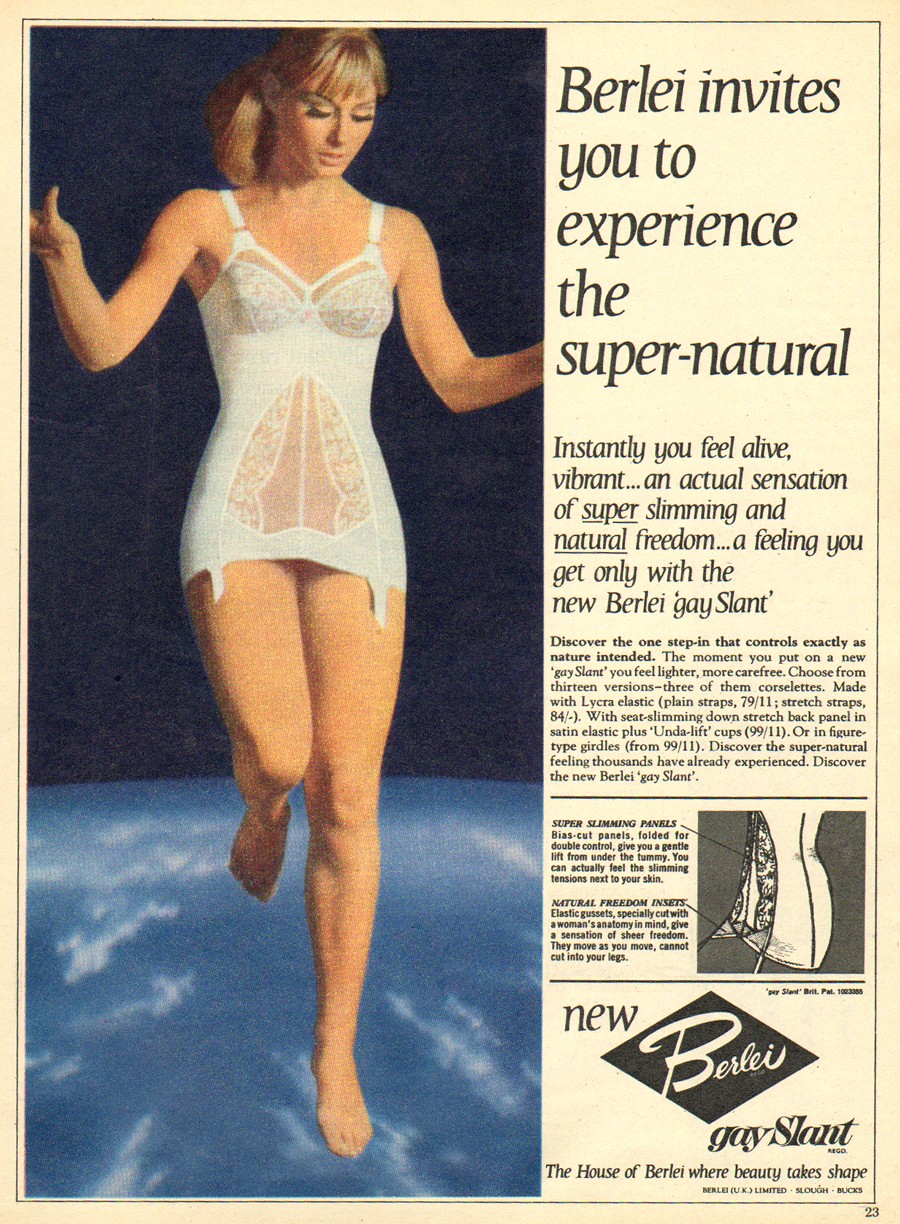Gypsy Creams
Do you have a gay slant?

Woman's Realm / 18th March 1967
Eeh, I’m a one.
Tags: Berlei, fashion, girdles, retail
6 Comments
Kianna on 4 August 2010 @ 9pm
This blog is super entertaining to me, as an American who grew up in the 1970s. It’s fascinating to see the tropes that did(n’t) translate across the Atlantic.
Confused about this ad, though. Did this contraption cost £79 when it came out? Does 79/11 refer to shillings and pence instead? Or is it a measurement of length? Currency converter from old money to new money isn’t helping.
Tanya Jones on 5 August 2010 @ 9am
Hi Kianna! Pre-1971, the British pound was made up of 240 pence, which was grouped into 20 shillings. Each shilling was made up of 12 pence. Prices were written ‘pounds/shilling/pence’ or, more accurately, ‘£/S/d’. So 79/11 is indeed shillings and pence (it’s one penny away from being 80 shillings, which is the old version of the £1.99 trick to make you think you’re not paying nearly £2).
I don’t actually know why prices were quoted like this when actually, the item costs £3/19/11, but presumably it was another way of trying to trick consumers into thinking they were paying less than they actually were. Can you believe that there are still people in Britain who miss this system? I’m fairly confident that the computer age would have been a lot harder for the UK if we hadn’t gone decimal when we did.
This Wikipedia link is a good reference: http://en.wikipedia.org/wiki/%C2%A3sd
Kianna on 12 August 2010 @ 12am
Thanks, Tanya! I knew about decimalisation, but had no idea prices would ever be listed as S/d if the cost was over a pound. Although I have no trouble believing there are Britons who miss the system… over here we still use imperial measurements, and if we ever go fully metric, I would really miss feet and inches and ounces and quarts. :) Off to read the wiki article.
Tanya Jones on 14 August 2010 @ 9am
Glad you found it helpful! I wasn’t quite clear: there are still people who miss pre-decimalisation money, which puzzles me, given that addition and subtraction were more complex than under the decimal system. We have an awkward mis-mash of imperial and decimal measurements here, and certainly people are still attached to stones, pounds and ounces, so much so that independent grocers often price in both imperial and decimal, although supermarkets now price in decimal only. In fact, some grocers became ‘metric martyrs’, because they didn’t want to provide the required decimal pricing along with the old imperial ones. Also, we still measure distance in miles and yards, although, again, metric is sometimes used as well.
The main objection, it seems, to changing systems, is the fear that prices go up, but I don’t think there’s any evidence to support this assertion. I personally think it would be better for the UK just to change everything to metric, but I’m not that sentimental about the system I use to measure things!
Londis on 30 August 2010 @ 9am
> I wasn’t quite clear: there are still people who miss pre-decimalisation money, which puzzles me, given that addition and subtraction were more complex than under the decimal system.
If my Dad is anything to go by, a lot of it is to do with smugly having something difficult under your belt as second nature.
I have a newsagent near me who keeps saying “that’ll be 20 shillings” whenever I pick up the Guardian. I want to tell him that 5 “new pence” is only 1 shilling if we’re using the long-out-of-circulation larger coins. Obviously it wouldn’t be true, but there is something pleasing about remembering when 5p, 10p and 50p coins were much larger, and with it, a time when 1 and 2 shilling coins were still in circulation.
The same guy cheekily sneaked an oversized 50p into my change the other week! Was quite nice.
TheLeen on 20 July 2010 @ 10am
Adverts on tv: sweets, diet product, sweets, diet product, sweets, diet product, sweets, diet product, sweets… obviously it has never been different.